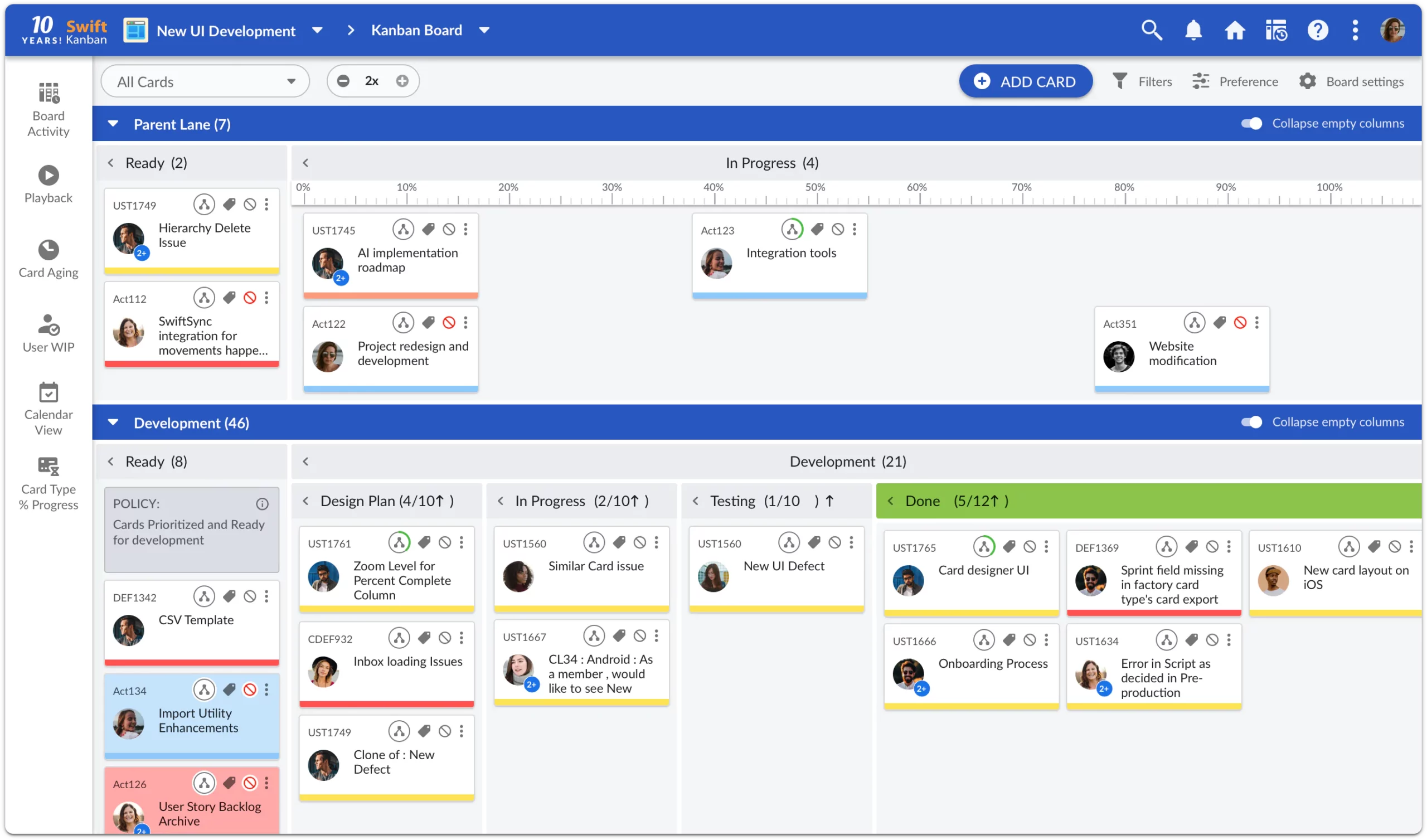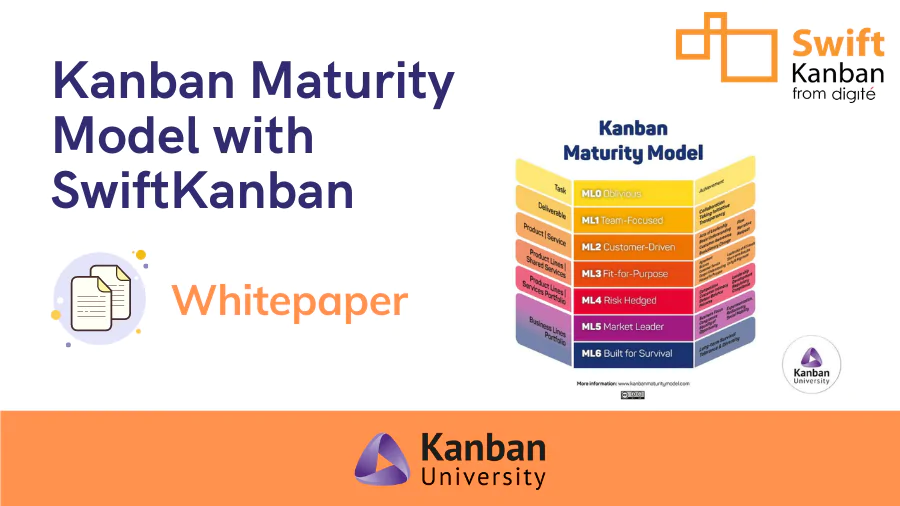Kanban is one of the most popular ways of working and if your organization isn’t already using it, then there are a number of reasons to start. In a webinar, David J. Anderson illustrates why organizations should choose to implement Kanban as well as when and how to go about adopting it. This article contains a summary of the ideas shared and we hope you learn more about Kanban through it. You can watch the full webinar here!
Cheers,
Joaquin Aceron
Markets are changing, and the way we work has to change with them. Today, businesses are shifting away from linear, structured workflows to being more flexible. Of the many frameworks that businesses are starting to adopt, Kanban is one of the most popular. To understand why this is, let’s look at what Kanban is about.
What is Kanban?
Kanban as a method is designed for the evolutionary and continuous improvement of organizations and work processes. It is a method used to track the progress and flow of tasks within an organization. The method has six core practices. There are as follows:
Visualize the workflow
To use Kanban, you first need a Kanban board. At the simplest level, it is a board separated into three columns: To-Do, Doing, and Done. Visualizing the workflow allows stakeholders within the organization to track the progress of deliverables and make adjustments when necessary.
Limit Work-in-progress Work-In-Progress (WIP)
In today’s volatile markets, you need to create value for your customers as soon as possible. When something is a WIP, or Work-In-Progress, it’s not providing value to your customers. WIPs need to be limited to increase speed of delivery.
Limiting WIPs primarily helps in avoiding overburdening at all levels. Setting WIP limits on each process step ensures that problems with the workflow become visible on the board.
Manage Flow
Kanban helps us to manage flow by helping us to identify blocking issues and bottlenecks. Once identified, we can then begin implementing improvements to reduce likelihood and impact of blockers. This helps achieve consistency, punctuality and good economic results, while anticipating customer needs.
Make policies explicit
Delays in the workflow can often come from policies implemented to mitigate or manage risks. By making these policies explicit, we can enable open conversations about risk and appropriateness of current policies. This allows for greater flexibility in the system.
Implement feedback loops
In Kanban, feedback is formalized and implemented not just within the team, but also between teams and between team members and their coach or manager. More informal and continuous ad-hoc retrospection and mentoring is also encouraged in order to nurture a culture of learning.
Improve collaboratively, evolve experimentally
Traditionally, businesses’ decisions would be made solely by upper management. This kind of practice assumes that only they have the capability to create good ideas and can predict where the market is going to go. However, modern organizations cannot operate with this kind of culture.
For Kanban to be effective, there needs to be a culture of collaboration within an organization. This is where anyone, regardless of their level within the company, can give their input and suggestions. Good ideas, and areas for concern, can come from anywhere so team members should be encouraged to speak up.
When should we Implement Kanban?
Kanban and its core practices are a new way of working and can help your business improve upon its current methods. You should implement Kanban when you want your business to improve in three key areas. These are:
1. Sustainability
Overburdening has always been a challenge for businesses, especially those following traditional, linear models. When given too much work in an unorganized manner, teams and individuals tend to feel overloaded. This not only causes delays in delivery but also lowers morale.
By managing the flow and reducing WIP and other delays, Kanban makes the flow of work easier to handle. This is both at the individual level and team level. This helps make teams more efficient at handling work.
2. Service Orientation
In today’s markets, customer demands have to be met because of the amount and level of competition that has been given rise in recent years. Modern businesses should always be looking to improve how they deliver value to their customers.
Kanban helps improve customer satisfaction by improving the flow of work. This then leads to decreasing delivery times and making them more predictable for both internal stakeholders and customers. This means that Kanban can help get your product into the hands of customers much faster to satisfy their needs. Feedback loops then allow your business to learn what the customer wants to see next from your product and continuously improve upon it.
Additionally, by relieving your teams of overburdening, the overall quality of their output tends to be higher.
3. Survivability
Traditional business models focused on predicting change. However, they don’t work as effectively when used in today’s markets, which are volatile, complex, and filled with uncertainty and ambiguity.
Kanban is more flexible than traditional models and helps businesses cope with this reality. By being more adaptable, businesses are able to respond to market shifts faster and more effectively.
How do we Implement Kanban?
Before implementing Kanban, the entire organization must buy into the idea of the shift. Otherwise, there could be certain failure modes that occur during implementation. Many businesses have failed to implement Kanban because of these failure modes:
1. Overreaching
This failure tends to happen when an organization tries to implement Kanban too suddenly. Some teams are attached to the current, traditional ways of working, and won’t instantly accept Kanban. When an organization isn’t ready to fully accept Kanban, but management insists on pushing for it, then there will be a disconnect within the organization.
2. False Summit Plateau
On the other hand, businesses experience False Summit Plateau when they feel that Kanban can no longer give them any further benefit. However, we’ve already established that Kanban gives organizations what they need to address their problems.
The question then becomes how do businesses avoid these failures? This is where the Kanban Maturity Model comes in.
The Kanban Maturity Model
Organizations can use the Kanban Maturity Model (KMM) to ensure maturity of the method usage within the organization and show how to achieve true business agility. The Kanban Maturity Model provides pragmatic, actionable, evidence-based guidance and depicts how to successfully deploy the Kanban Method to greatly improve the economic performance of your organization. Specifically, it informs how to process improvement from small-scale teams and departments to entire organizations.
KMM has 7 maturity levels for Kanban teams. Going from individual gain over to the long-term company goals, these levels represent each step of the Kanban process:
Maturity Level 0 – Oblivious
At this level, the people of the organization are unclear and mainly focused solely on their personal tasks without a structured approach and team vision. At this stage, your team may realize that limiting work in progress helps in avoiding multitasking and reducing lead times for delivering tasks.
Maturity Level 1 – Team-focused
At this level, your organization is already talking about team tasks, yet there is still no established culture of full collaboration. By this time, a team kanban board should already be used and each individual’s tasks are visualized. In addition to organizing the flow of work, it creates transparency and facilitates collaboration. At this level, there is likely a leader figure starting to emerge within the team.
Maturity Level 2 – Customer-driven
At this level, the work process should be transparent. The next step is that the team should start to understand the way they perform tasks. At this stage the team typically starts to realize the need to define work processes and how tasks are going to be completed. However, there is still a lack of stability in delivery due to unpredictability.
Maturity Level 3 – Fit-for-purpose
Upon reaching Maturity Level 3, your organization should already have defined its process, workflow, policies, and decision frameworks. Your whole team must agree on all of them and understand how they help them achieve better results. Your main goal should be further improving all six core practices of Kanban.
Maturity Level 4 – Risk Hedged
Kanban Maturity Level 4 is characterized by a risk hedged process and data-driven decisions. It is characterized more by adopting Kanban Cadences and adopting the Fit-For-Purpose Framework than specific Kanban board designs. Typically, there is still some progress to be made at this level for workflow visualization and management. At this level, the goal becomes evolving your management practices and processes even further.
Maturity Level 5 & 6 – Market leader/ Built for Survival
By now, organizations should visualize fixed teams and shared resources, such as floating workers, across aggregated services. At these levels, problems such as managing WIP and workflow should already be managed well. However, that is not to say there is no more improvement that can be made, as organizations should constantly be finding ways to improve their current processes. The problems then become utilizing hybrid fixed-service teams and a flexible labor pool and aligning strategy with capability.
The KMM provides a detailed roadmap for organizations on how to grow, analyze, and improve their standing. When adopted in conjunction with Kanban automation software, the KMM enables organizations to evolve and improve processes, business outcomes and customer expectations, and drive business resiliency and robustness more than traditional systems could in modern markets.
Summary
Kanban systems are an appropriate choice for improving service delivery when there is a need for greater predictability in delivery times, higher quality in deliverables by limiting plannings and meetings, and deferred commitment through a service delivery flow. The use of Kanban systems can save money by reducing wasteful upstream activities such as planning and prioritization.
If you want to explore SwiftKanban, you can check out our rich set of features or if you’re looking for a free Kanban board sign up for SwiftKanban Here!








